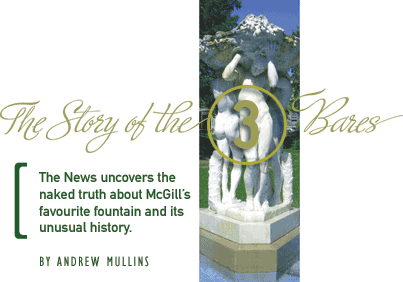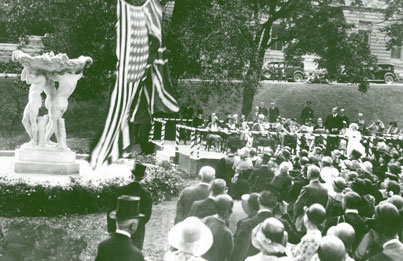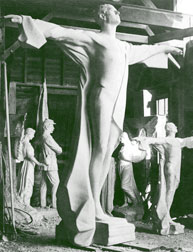
For decades, McGill students have trooped past it day after day or relaxed with friends in the hollow where it stands, just west of the main campus avenue. It is the most recognizable art object on McGill grounds, and it has become nearly as iconic of the University as the cupola on the Arts Building or the Roddick Gates. Few of the students who pass by, though, could tell you the story of the fountain everyone knows as the Three Bares. There is no historical marker, no nameplate acknowledging the benefactors - just a marble statue in a small octagonal pool, brightening up the tree-lined dell that is overshadowed by the Redpath Museum.
In the 75 years since the Bares first came to McGill, the statue has meant many things to many people. For Sir Arthur Currie, McGill's principal when the "Good Will Fountain" was presented as a gift in 1930, it was an annoyance and unanticipated expense in the middle of the Great Depression. For one prudish graduate of 1911 who wrote to the McGill Daily to "deplore the erection of three naked male figures in a prominent position on the Campus," the statue was "a menace to our pure-thinking girls and boys" (although the letter was quite possibly a hoax). The statue's creator, Gertrude Vanderbilt Whitney, offered a cryptic description, claiming it was "symbolic of the nation's strength implanted in the fertility of the soil." It has been the target of pranks and the subject of paintings, and at each Convocation a steady stream of graduating students and their families pose for souvenir snapshots in front of the once provocative young men. Few would think the statue controversial today, but anyone who has attended McGill since the 1930s can recall the Three Bares.

The official unveiling of the Three Bares in 1931
McGill Archives
Kitsch or Culture
"Great Art they are not," says Faith Wallis bluntly - fond as she is of the Bares - "and the fountain has never really worked properly." Wallis, BA'71, MA'74, MLS'76, is a McGill professor of History and Social Studies of Medicine, who researched the statue for McGill Archives in 1976. Its value may be questionable, "but the tale of how Whitney and her celebrity buddies managed to con McGill into giving this rather dubious piece of kitsch a home is part of our ludic legend."
The fountain started as the brainchild of Ellen Ballon, DMus'54. As a child piano prodigy in the early 1900s, Ballon studied at the McGill Conservatory with its celebrated instructor, Clara Lichtenstein (later in her career, Ballon was described by the virtuoso Artur Rubinstein as "the greatest pianistic genius I have ever met"). She left the Conservatory for further schooling in New York - funded by the patronage of Prime Minister Sir Wilfrid Laurier, BCL1864, LLD1898, and McGill principal Sir William Peterson - and debuted with the New York Symphony at the age of 12. As an adult concert pianist, Ballon moved in prominent artistic and social circles and eventually turned part of her attention to philanthropy. Before the Good Will Fountain project, she had established a piano scholarship in her name at McGill's Faculty of Music in 1928.
One of Ballon's important friends in New York was Gertrude Vanderbilt Whitney, a daughter of the Vanderbilt financial empire who had married into another of America's Gilded Age fortunes when she wed Harry Payne Whitney. In her 20s, at around the same time the younger Ballon was amazing McGill audiences with her childhood aptitude for Beethoven, Whitney embraced the world of art. She began to study sculpture, first in New York, and then in Paris under the great French sculptor Auguste Rodin. Working in her own studios in Greenwich Village and Paris, Whitney eventually had works on display in the U.S., Spain, France and South America. Her sculptures included war memorials, fountains - her ornate Fountain of El Dorado done for the World's Fair in 1912 in San Francisco would end up in Lima, Peru - even a statue of Wild West legend Buffalo Bill Cody.

Gertrude Vanderbilt Whitney's 18-foot granite memorial statue commemorating the victims of the Titanic disaster before it was put on permanent public display in Washington.
Photo courtesy Thomas Crane Public Library,Quincy,MA
Her Titanic Memorial commemorating the heroism of the men on the doomed ship who had insisted on "women and children first" was unveiled by U.S. President Herbert Hoover in Washington, D.C., a few days before the Three Bares would be presented at McGill (and the stance of the figure in Whitney's memorial, with its cruciform, outstretched arms, will be familiar to fans of the 1997 blockbuster movie about the disaster).
In addition to her sculpture, Whitney became a philanthropist and patron of the arts, with an important, growing collection of contemporary American works from artists she had sponsored. When she offered the collection - and a new wing to house it - to the Metropolitan Museum of Art in New York, she was rather shortsightedly turned down, and she went on to become the first woman to found a major art museum, opening the Whitney Museum of American Art.


